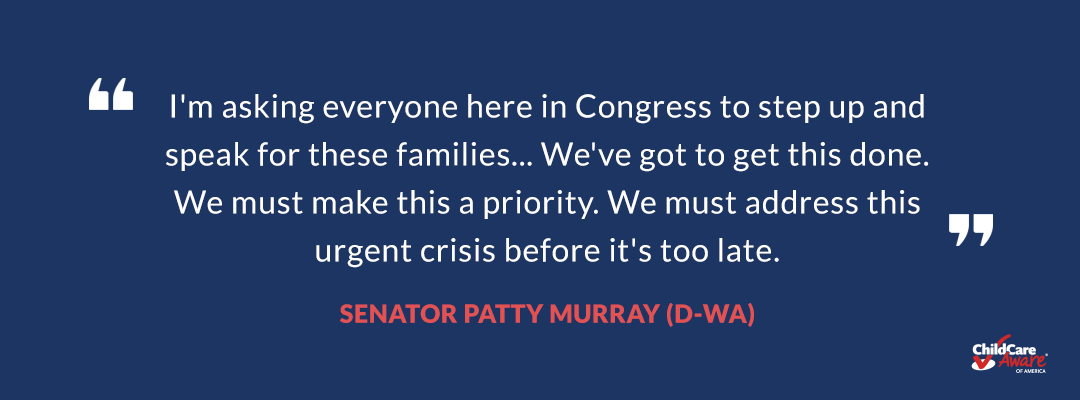 In partnership with CHILDREN AT RISK, Child Care Aware® of America (CCAoA) developed a new data dashboard to study the child care landscape in Texas from March 2020 to September 2021. Data from this new tool shows that federal relief funding had a positive effect on keeping child care program recipients in Texas open as they endured the early effects of the pandemic. This blog explores this data dashboard, its findings and how data can be used to advocate and inform policy outcomes.
In partnership with CHILDREN AT RISK, Child Care Aware® of America (CCAoA) developed a new data dashboard to study the child care landscape in Texas from March 2020 to September 2021. Data from this new tool shows that federal relief funding had a positive effect on keeping child care program recipients in Texas open as they endured the early effects of the pandemic. This blog explores this data dashboard, its findings and how data can be used to advocate and inform policy outcomes.
CHILDREN AT RISK (CAR) is a nonpartisan research and advocacy nonprofit dedicated to understanding and addressing the root causes of child poverty and inequality in Texas. Established in 1989 by Houston child advocates and researchers, CAR has grown into a statewide organization tackling Texas children and families’ most pressing needs.
About the Dashboard and Methodology
This dashboard illustrates the operational status of Texas early care and education providers from March 2020 – September 2021 by aggregating programmatic descriptive statistics (e.g., type of care, licensure, Texas’s quality rating and information system participation, geography, subsidy participation). Users can filter the dashboard to calculate custom aggregate statistics and use the map to view even individual providers.
The data analyzed by CCAoA in partnership with CAR was provided by the Texas Health and Human Services Commission and contains operational status of child care providers from March 6, 2020, to September 21, 2021. It also uses 2019, 2020 and 2021 snapshot data from the Texas Workforce Commission for child care subsidy enrollment and quality status, known as Texas Rising Star. The data dashboard uses a sample size of 18,734 providers in child care and family child care settings throughout Texas with a total licensed capacity to serve 1,144,379 slots.
All child care providers, regardless of age of children served, were included in this analysis, though child care homes were only available after the first six months examined due to limited data availability from the Texas Health and Human Services Commission. A closure is defined in this dashboard as a child care provider with an operation status not listed as open at the end of the period examined.
This data dashboard was developed with the generous support of the Alliance for Early Success, which provides technical assistance and targeted investments to early childhood advocacy allies nationwide that are pursuing policies that improve outcomes for our youngest children.
Using the Data Dashboard
The data dashboard is interactive, allowing users to expand sections and apply multiple filters and geographical preferences to explore the landscape of child care in Texas during the first year of the pandemic. More information on the mapping elements and a user guide can be found on the dashboard itself.
To provide a brief overview, users can narrow the dashboard data in a few different ways. On the right side, users can select a geographic filter to narrow information down by county, workforce board, state house district or state senate district. On the left side of the dashboard, users can select multiple child care program filters, including type of care, level of licensure, Texas Rising Star quality rating, programs serving infants and/or toddlers, programs accepting subsidies and stabilization grant recipients as of September 2021.
When various child care program and geographic filters have been applied, users can find data displayed in the top-center of the dashboard reflecting the number of providers, licensed capacity and average subsidy enrollment information for 2019 and 2020. This can be further broken down for information on subsidized infant and toddler averages.
The bottom-center “donut” infographic shows the share of providers listed as “open” at the end of our study period (September 21, 2021) out of all the providers with operational status data on that date. Users can toggle through the donut widget to see operational status breakdowns for this date by Texas Rising Star providers, infant and toddler providers, providers accepting subsidies and federal stabilization grant recipients.
Users can zoom into the map to view summaries for clusters of child care providers at a variety of scales. View the legend in the upper right corner of the map icon for information on what different map symbols and colors mean.
Texas Child Care Dashboard Findings
The dashboard shows information about child care closures and the Texas child care landscape between March 2020 – September 2021. From the sample of 18,734 providers, the data found that:
- 78.8% of providers remained open between March 2020 and September 2021 (or, 21.2% closure rate).
- Out of 9,639 child care centers, 90.3% remained open by September 2021. Of the sample’s 9,095 family child care homes, many of which are located in rural areas, only 69.1% remained open by September 2021.
- 14,158 (75%) of total child care programs of this sample did not participate in Texas Rising Star quality rating system.
- By September 2021, 87.1% of non-Texas Rising Star programs remained open. On the other hand, 95% of the 1,104 child care programs with a top-tier (4-star) Texas Rising Star rating remained open by September 2021.
- 7,517 (40%) of total child care programs accepted subsidy. By September 2021, 89.5% of those providers remained open.
- Out of 12,700 (67.8%) total child care programs with infant/toddler slots, 88% remained open by September 2021.
- Only 1.6% of programs that received stabilization grants closed from March 2020-September 2021, suggesting this funding had protective effects.
Stabilization Grants Helped Keep Programs Open
The dashboard shares important information about the stabilization grants in Texas, called Child Care Relief Funding 2021, and what they meant for programs that received them. Forty-eight percent of providers from the dashboard sample received stabilization grants between March 2020 and September 2021. While this initial number seems low, the grant application window for this funding closed at the end of July 2021, near the tail end of our dataset, and it took a few months for awards to reach providers. Data from the Texas Workforce Commission shows that outside of the dashboard dataset, many more providers (72.4%) statewide received stabilization grants by December 2021. It should also be noted that some of the programs included in this data sample may have been closed when funding was available and therefore did not apply.
For the programs included in the dashboard that received funding in 2021, additional federal dollars to providers had a positive effect on keeping programs open during these months of the pandemic. The data shows that stabilization grant recipients participating in Texas Rising Star, serving infant/toddlers or accepting subsidy remained open at very high, consistent rates— between 98.3%-98.8%. The data made available by the dashboard makes the case for why additional investments at the federal and state levels are needed to stabilize and strengthen the child care system in Texas (and in all states!).
More highlights from the dashboard related to stabilization grant recipients in the sample used for the dashboard can be found below:
|
Stabilization Grants & Child Care in Texas (March 2020 – September 2021) - Dashboard data sample size: 18,734 providers- 8,970 providers (48%) received stabilization grants |
||
|
Program Filters |
Total Dashboard Sample |
Stabilization Grants Filter |
|
Texas Rising Star (TRS) Providers |
94.5% of entire sample who participated in TRS remained open in September 2021. |
Of those who received stabilization grants, 98.8% of TRS providers remained open in September 2021. |
|
Providers with infant/toddler slots |
88% of entire sample with infant/toddler slots remained open in September 2021. |
Of those who received stabilization grants, 98.4% with infant/toddler slots remained open in September 2021. |
|
Providers who accepted subsidy-eligible families |
89.5% of entire sample who accepted subsidy-eligible families remained open in September 2021. |
Of those who received stabilization grants, 98.3% who accepted subsidy-eligible families remained open in September 2021. |
Using Data to Advocate for Policy Change in Texas
Accurate data can be a powerful and effective tool to educate both the public and policymakers about child care issues, and to advocate for change. To strengthen its advocacy efforts, CAR is using the data insights from the dashboard to inform the field and legislators about the child care landscape in Texas.
Throughout April 2022, CAR hosted 10 virtual roundtable discussions with child providers, advocates and other partners to discuss their new report, the Quest for Equity & Quality, present the new dashboard data on childcare closures through the pandemic, and invite participation in advocacy ahead of the upcoming legislative session. During these roundtables, CAR shared data from the dashboard on statewide closures and the stabilizing effect of federal relief grants administered. Each roundtable ended with a call to action to contact Texas state legislators to ensure they are prioritizing child care going into the 88th Legislative Session.
On May 19, 2022, CAR provided testimony to the Texas House Committee on International Relations and Economic Development that shared data on child care closures and the protective effect of the stabilization grants found in the dashboard. CAR also outlined five recommendations to the committee to strengthen the early childhood education sector in the upcoming 88th legislative session:
- Support and strengthen the child care workforce through compensation and education.
- Remove barriers and incentivize partnerships between independent school districts and high-quality child care providers to maximize taxpayer dollars and to increase pre-kindergarten and child care capacity for working parents.
- Improve access to quality child care across settings for working parents.
- Increase reimbursement rates for child care providers providing higher quality care.
- Increase state investment in child care.
Looking Ahead
As Texas approaches its 88th legislative session in January 2023, the message will be loud and clear: as Texas’ economy returns to pre-pandemic heights, access to high-quality child care for all Texas families and employers is more important than ever. Yet our child care system is still struggling. Using this dashboard will help tell this story, not only at the statewide level but at individual legislative district levels as well. Data statistics from their home district coupled with advocacy from constituent providers and families will allow each Texas State Representative and Senator to understand the impact on their constituents.
The stabilization grants worked. Child care providers across the state have been able to keep their doors open and pay their staff higher wages. However, they are neither a cure-all nor in endless supply; this is short-term money and the timeline for states to spend down federal relief funding is approaching quickly—by September 2023, states must liquidate (or spend) funding under the first two federal relief bills, along with the stabilization funding under the American Rescue Plan (ARP) Act. By September 2024, states must spend the last of the ARP Act supplemental CCDF discretionary dollars.
Along with greater permanent federal funding, Texas (and every state) needs now more than ever a true investment of public dollars to help support child care programs. Child care providers simply cannot afford to continue to support the child care system with their own money and labor. These small businesses – most often run by women and often by women of color– deserve the respect provided to other businesses in Texas and across the nation. It will be critical to focus our advocacy efforts going forward on securing transformative funding for child care, and data can be an effective tool to use toward these efforts.




